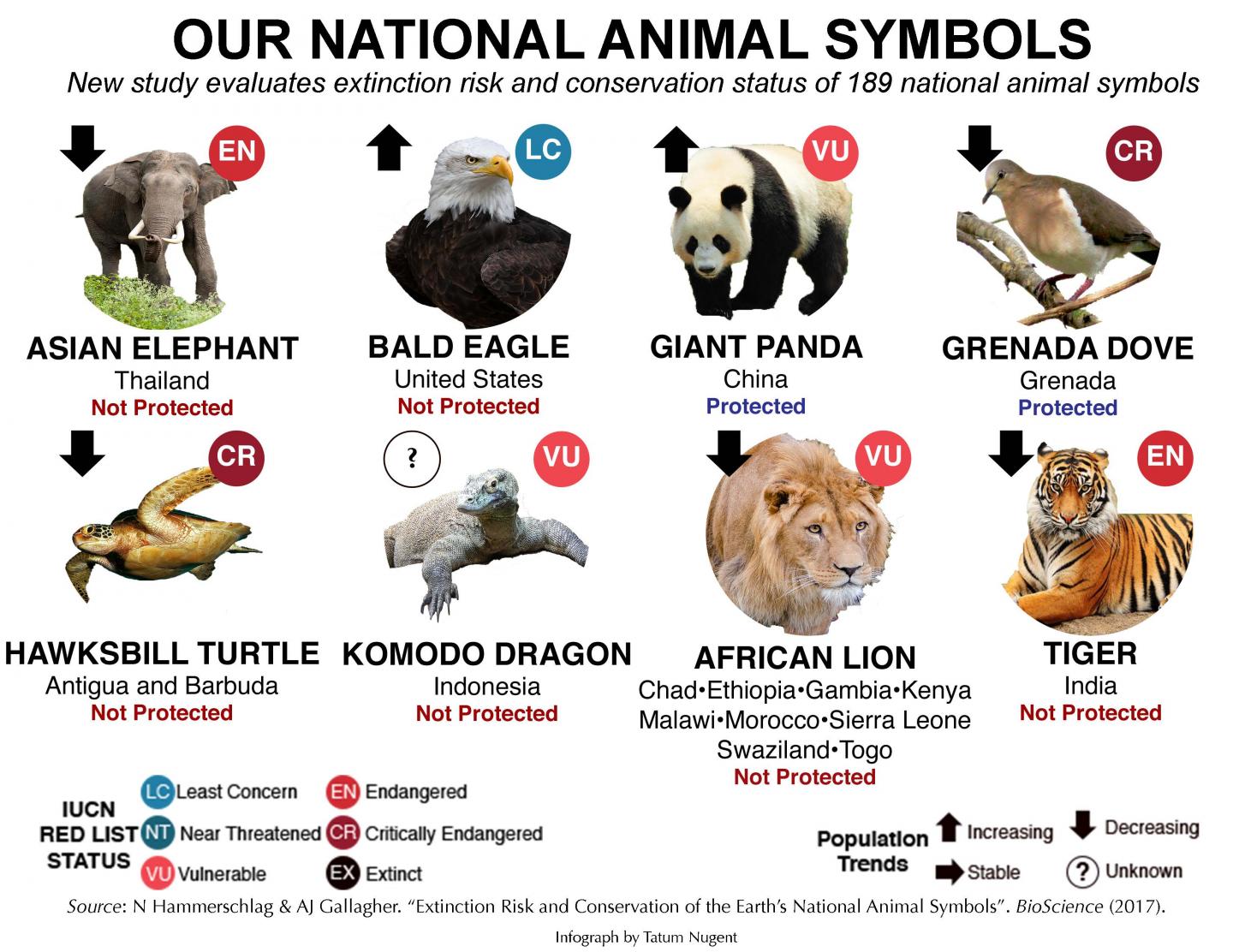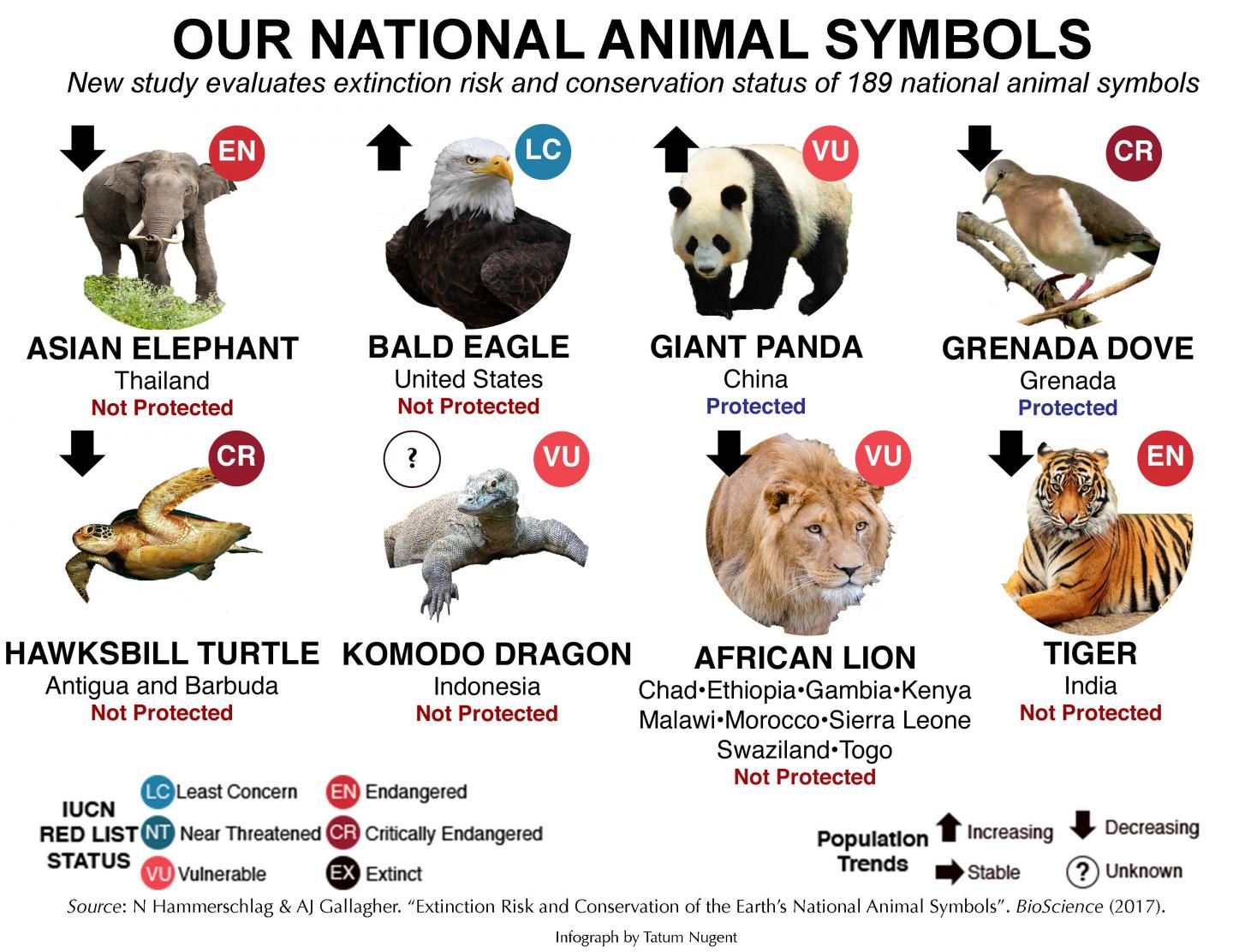
Credit: Tatum Nugent
MIAMI — The snowy-feathered head and distinctive brown body of the bald eagle is a proud national symbol of the United States, adorning the country's currency and passports. The lion, known as "King of the Beasts," represents national strength and identity in several African countries.
But, how are populations of the planet's most valued wildlife fairing in the 21st centry? How well are societies protecting the species they have chosen to embody their ideals and represent their national identity?
In a new study, scientists from the University of Miami (UM) Rosenstiel School of Marine and Atmospheric Science assessed the extinction risk and conservation status of all the world's national animal symbols. The 189 animal symbols assessed ranged from the lion and bald eagle to the turtle dove and common loon.
The analysis by UM researchers Neil Hammerschlag and Austin Gallagher found that an alarming 35 percent of the world's national animal symbols are threatened with extinction and 45 percent are experiencing population declines. They determined that the primary threats facing national animal symbols are killing for food, human-wildlife conflict, and habitat loss.
The researchers were surprised to find that only 16 percent of all symbols were receiving any sort of national protection within the country in which they are considered symoblic. The also found that populations of national animal symbols represented by North America and Australia-Oceania were faring better than those found within the African continent, which hosted the highest proportion of threatned animal symbols by geographic region.
"If current population trends persist, over 50 percent of national animal symbols may face future extinction," said the study's lead author Hammerschlag, a research assistant professor at UM's Rosenstiel School and Abess Center for Ecosystem Science & Policy. "This clearly shows the opportunity for individual countries to protect their own national symbols."
The researchers analyzed data from the IUCN Red List to assess the threat and conservation status of national animal symbols, representing 127 countries, including some countries who share national symbols. The Africa lion, for example, is the national animal symbols of Morocco, Togo, Gambia, and Sierra Leone, although the lion already went extinct wthin the borders of these countires. Some countries, including the U.S. have taken specific conservation actions that have allowed populations of the once-threatened national symbol, the bald eagle, to recover and now thrive, demonstrating that these animals can be conserved with appropriate conservation action.
"Given the potential significance of animal symbols to national and personal identity, it may be relatively easy to garner public support and protection for these animals such that they may continue to function as not only a national symbol, but also a flagship species indirectly supporting the conservation of other species and their habitats," said study co-author Gallagher, an adjunct assistant professor at UM Rosenstiel School and director of the non-profit Beneath the Waves Inc.
"The results of the study pose a sobering question, if a country isn't able to conserve or protect its own national symbol, what hope do any other species in that country have?" said Gallagher. "Local conservation initiatives may benefit from generating increased awareness of threats facing national animal symbols."
The researchers note that it may be relatively easy within a country to garner support for national animal symbols as flagship species if citizens become aware of the risks they face. "The fact that countries have been able to bring their national animal symbols back from near-extinction through strong conservation efforts is an important lesson and excellent sign of hope for all nations," said Hammerschlag.
###
The study, titled, "Extinction Risk and Conservation of the Earth's National Animal Symbols," was published on May 23, 2017 in the journal BioScience, published by the American Institute of Biological Sciences. DOI: https://doi.org/10.1093/biosci/bix054
Link to interactive map info graph: https://www.thinglink.com/scene/923771552942522369
About the University of Miami's Rosenstiel School
The University of Miami is one of the largest private research institutions in the southeastern United States. The University's mission is to provide quality education, attract and retain outstanding students, support the faculty and their research, and build an endowment for University initiatives. Founded in the 1940's, the Rosenstiel School of Marine & Atmospheric Science has grown into one of the world's premier marine and atmospheric research institutions. Offering dynamic interdisciplinary academics, the Rosenstiel School is dedicated to helping communities to better understand the planet, participating in the establishment of environmental policies, and aiding in the improvement of society and quality of life. For more information, visit: http://www.rsmas.miami.edu.
Media Contact
Diana Udel
[email protected]
305-421-4704
@UMiamiRSMAS
http://www.rsmas.miami.edu
############
Story Source: Materials provided by Scienmag





